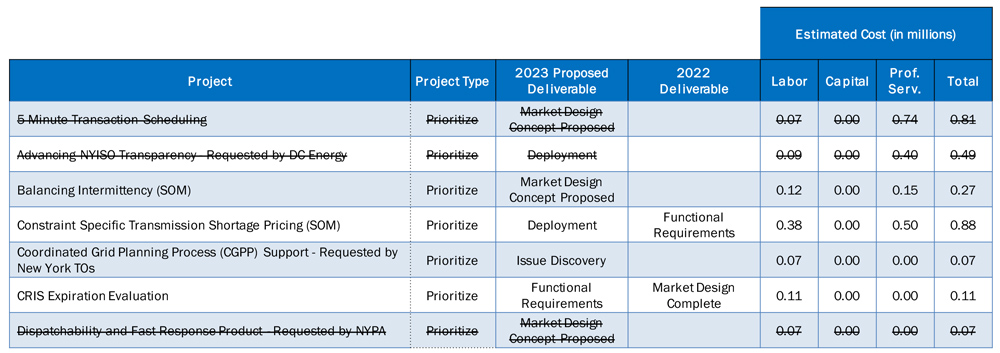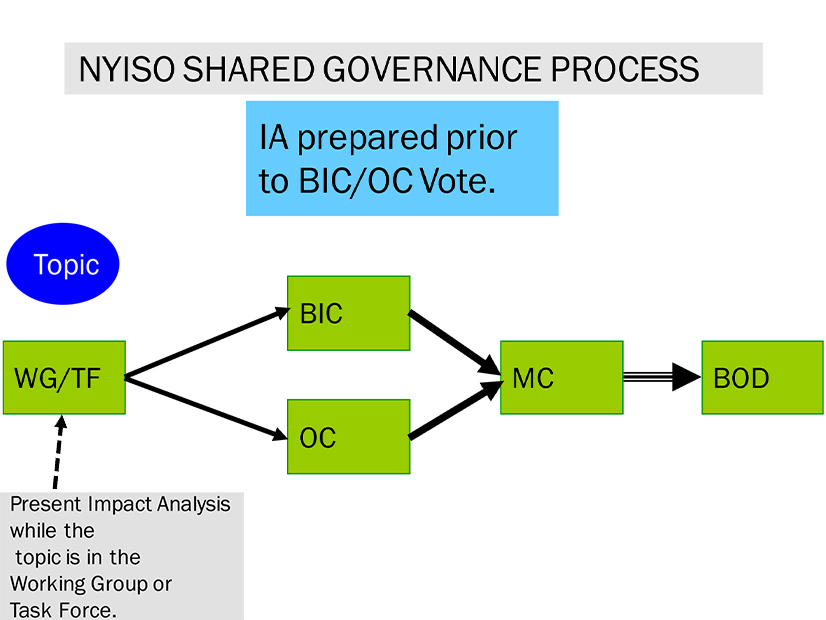NYISO is proposing a $32 million project budget for 2023, a $5 million reduction from this year’s spending.
NYISO’s Brian Hurysz, who presented the final project recommendations for the 2023 budget to the Budget and Priorities Working Group (BPWG), said 13 of the 24 projects that had been identified as stakeholder priorities were included in the spending plan.
The $31.98 million budget includes $13.7 million for labor, $9.7 million for capital and $8.5 million for professional services, $5.2 million lower than the 2022 project budget of $37.2 million. The 2022 budget increased project spending by $10.7 million over 2021 largely because of the Alternate Control Room Renovation project, which was deferred from 2021, and the Distributed Energy Resource Integration project.
The market and enterprise budget recommendations were $11.36 million and $20.62 million, respectively.
In addition to deferring 11 of the 24 proposed market projects, including the duct firing modeling that NYISO desired, the ISO is recommending cost savings or scope changes for some projects:
- The Distributed Energy Resources (DER) Participation Model will be delayed, with deployment planned later in 2023. The cost of the project has increased, and the operational enhancements have been reduced.
- Storage as Transmission, requested by stakeholders, will be limited to “issue discovery” — education sessions and identification of potential solutions for future ranking — in 2023.
- Capacity Resource Interconnection Service (CRIS) Expiration Evaluation & CRIS Tracking: CRIS Tracking will be deferred to 2024; CRIS Expiration Evaluation will develop CRIS Tracking requirement updates and be implemented with CRIS Tracking in 2024.
- FERC Order 2222 Compliance: Scope of the project has increased based on updated information from FERC. The ISO recommends changing commitment from completed documentation of Functional Requirements (FRS) to Market Design Concept Proposed (MDCP).
- Balancing Intermittency & Dispatchability and Fast Response Product: The ISO proposes combining some of the Dispatchability and Fast Response scope with the Balancing Intermittency, which was recommended in Potomac Analytics’ State of the Market (SOM) project.
- Unified Communications Platform: The ISO recommends deferring the work until 2024, saying the equipment to be replaced is not end-of-life in 2023.

NYISO said stakeholder feedback on the budget can be emailed to Hurysz.
The ISO’s full 2023 draft budget will be presented at the Sept. 15 BPWG meeting and the Sept. 28 Management Committee meeting.
Compensation Benchmarking Study Boosts Pay for 300 ISO Staffers
NYISO will spend $2.5 million in 2022 to raise the salaries of about 300 non-executive employees in response to a benchmarking study commissioned to address increasing attrition.
NYISO Chief Financial Officer Cheryl Hussey said the ISO hired consulting firm Mercer to conduct the study after seeing an increase in attrition and the number of people rejecting the ISO’s job offers.
 NYISO Chief Financial Officer Cheryl Hussey | NYISO
NYISO Chief Financial Officer Cheryl Hussey | NYISOMercer reviewed compensation data on 525 employees in 247 job titles and found that certain positions — including entry-level grid operators, engineers, software developers, IT security and infrastructure analysts and technical specialists — “trended significantly below the market,” Hussey said.
The ISO agreed to spend $2.5 million to raise “about 300” such employees to the mid-point of their peer group, retroactive to July 1, she said. The cost of the adjustments will be about $5 million for 2023.
The ISO will use nearly half of its $10.7 million 2021 budget surplus to fund these raises and a prior 3% raise given to non-executive staff retroactive to Jan. 1.
Hussey said the ISO would continue monitoring market trends and adjust salary levels again if warranted. “More recently we have had more success in our recruiting. Our vacancy rate is down. But it’s really soon to show a significant change resulting from the latest salary adjustments,” she said.
Barring additional compensation adjustments, the remaining $5.7 million from 2021’s budget surplus would be used to pay down the principal on outstanding debt, which is expected to total $82.5 million at the end of 2022.
Four Projects in 2023 Budget from Consumer Impacts Analysis
The ISO’s Tariq Niazi said that the ISO is recommending four projects be included in the 2023 budget based on its consumer impact analysis:
- Balancing Intermittency (SOM): The project will examine existing ISO market structures and rules to help identify changes needed to maintain system reliability, while addressing the state’s climate goals cost effectively.
- Locational Capacity Requirements (LCR) Optimizer Enhancements: Will seek improvements to the LCR methodology to improve stability and transparency.
- Long Mountain PAR Operating Protocol: The ISO will develop an operating protocol with ISO-NE for the phase angle regulator (PAR) planned for the Long Mountain-Cricket Valley 345-kV intertie, an upgrade from the AC Public Policy Segment B project.
- Modeling Improvements for Capacity Accreditation (SOM): Continues the work of the Improving Capacity Accreditation project to allow consideration of reliability risks such as correlated fuel unavailability and long start up notifications not modeled by the current resource adequacy analysis software.
The ISO looks for projects that are anticipated to have a net production cost impact of $5 million or more per year; have an impact of more than $50 million per year on consumer energy or capacity market prices; incorporate new technologies into ISO markets for the first time; support a new type or category of market product; or create a mechanism for out-of-market payments for reliability.
Stakeholders expressed skepticism about the ISO’s proposal to improve the modeling used by the resource adequacy analysis software GE MARS. Stakeholders said this proposal “missed the mark” since GE MARS represented such a small amount of the total resources used by NYISO. In response, Niazi stated that he would take these concerns back to his team to reevaluate. But he stressed that having accurate accreditation calculations was critical to reducing costs and improving reliability.


